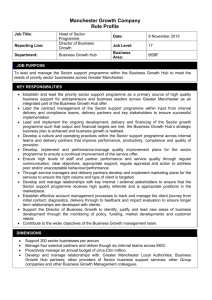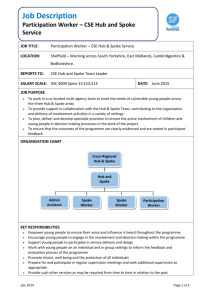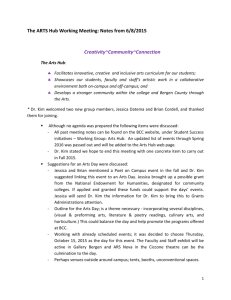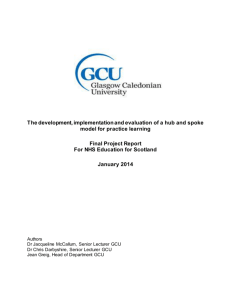toolkit models of hub and spoke
advertisement
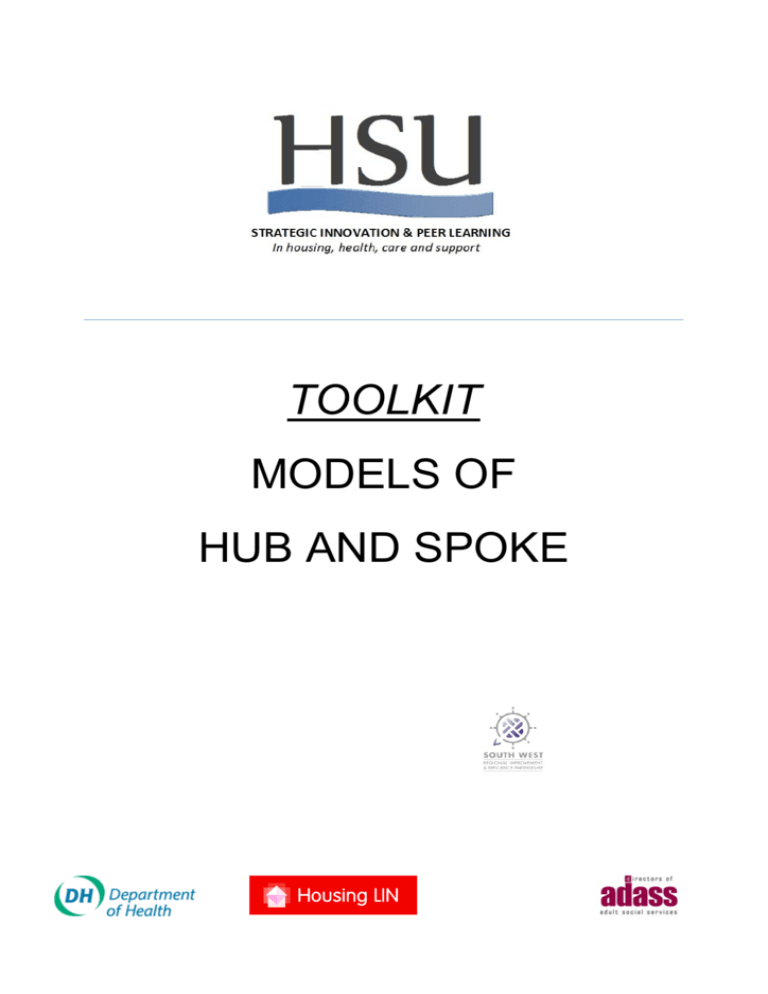
TOOLKIT MODELS OF HUB AND SPOKE The Hub and Spoke Model The geography and distribution of communities in the South West lends themselves to what is known as a "hub and spoke" models of service delivery, both for health care and for care and support. Hub and spoke models can offer services and facilities to the wider community, as well as to residents of the scheme. This means that a range of services including housing support can be provided from a central point over a defined geographical area to people within the surrounding community. It can also help to link smaller less cost effective schemes to a larger network of resource making them more sustainable, both in terms of shared costs, but also in providing a full range of services. For service providers, they can offer a working base not previously available and a network to allied agencies, working at a local level and with local knowledge. Staff consistently indicate that they can provide improved outputs for clients where they can establish networks with staff from other agencies working locally. This strategy proposes two models of hub and spoke, which can fit existing physical resources and be extended by the coordination and the joint commissioning to provide the services older people want. Community Hub Based at existing sheltered housing this model could suit schemes that have facilities that would enable them to extend the services they currently offer to the wider community and to extend the range of services that they offer to meet the needs of the growing older population. Example A Housing Association sheltered scheme with 35 units located in a village with other social housing and private sector housing in the area. The scheme has a lounge with a catering kitchen and adequate space to provide seating for 60. There is a well equipped laundry on site, a hair dressing/craft room and a small separate reading room/library. The scheme is fully DDA compliant with secure entry to the communal facilities and disabled parking. The scheme manager has an office. There is a 3 bed flat within the scheme that was used as scheme manager accommodation when staff used to be residential, but is now used for storage and staff training. The scheme currently has a scheme manager who works Mon - Fri 9-5, undertaking daily visits and out of hours the warden call system is switched to a contact centre, which calls on mobile warden services as necessary. The village has no GP practice or other health provision. The nearby town has a good range of amenities but there are infrequent transport links. The village has a school, range of small shops and a pub with well established family groups. Using this scheme as a hub and spoke model it would be possible to: • Link other properties in the community within a defined geographical area , to • • • • • the scheme with assistive technology, allowing the scheme manager to respond to calls in emergencies Provide calls or visits to older people linked via their alarms to the scheme on a daily basis. Provide a responsive service to alarm users, not linked to the scheme, in emergencies as a point of first contact. Invite older people using any of the above services to use the schemes communal facilities and join in events and activities (with the agreement of existing tenants). Allow other organisations to use the schemes as a base, converting the unused scheme manager accommodation to offices or treatment rooms. Provide a housing support service from the scheme to older people in the community wishing to maintain their independence The cost of the services would be recovered either through rents and service charges or directly to owner occupiers. Some would be able to use benefits or personalised care budgets to cover the cost where they are eligible. The service provider can tailor the staffing levels to meet the demands of the area and to ensure adequate cover is provided. Charges to other organisations should be levied to cover any additional costs, especially in staff resource to manage a busier scheme and wear and tear. If the scheme has adequate facilities and there proved to be sufficient demand, others services might be added and could include some or all of the following: • Provide community health services from the scheme on a permanent or ad hoc • • • • basis, to include clinics for diabetes, chiropody, district nurses, dieticians and GPs etc. Provide personal and domestic care teams, based at the scheme and working in the wider community Invite voluntary agencies to use communal facilities to provide day services for both tenants at the scheme and older people in the wider community Establish housing support, occupational therapy, home improvement and social work staff work stations at the scheme to work both at the scheme and in the wider community Provide a meals service to tenants at the scheme and into the wider community Some housing providers may wish to consider offering other services, currently available to their tenants to the wider community. We know that owner occupiers are concerned about the quality and cost of undertaking maintenance work to their home and garden and would welcome being able to access services easily and at any time from a quality contractor at a reasonable cost. Housing providers are well placed to offer these services and in doing so increase income streams. Super Hub Most schemes will not be able to accommodate a full range of services from existing facilities and in some areas there may not be sufficient demand to consider improvements to the scheme. However a fully integrated service for older people could be delivered from a single base, as proposed in the model we are calling a super hub. From the outset super hubs would provide a wide range of services from a range of statutory and voluntary agencies, with a core team of social care staff working 24/7 based at an existing Housing with Care or large sheltered scheme (in future purpose built communities) providing intensive personal care and support to residents at the scheme and tenants in the immediate community. This scheme would form the hub which would also be able to accommodate staff and surgeries from health, social services, housing and the voluntary sector, linked to community health and GP practices permanently or on an ad hoc basis. All services would be available to the tenants of the scheme, but would also extend in to the wider community to support older people of any tenure, tailoring support to meet needs. A super hub could also network to community hubs for less frequently used specialist services and to provide continuity of support and care, especially where older people may need to move from their own homes to sheltered, or housing with care. Services at a Super Hub • • • • • • • • • • 24/7 care team availability on site Extended care team and emergency response teams based at site Linked to contact centre for calls from the community Voluntary services offered facilities at site Meal provision available at (or from) site – canteen facilities Social activities and day services available at site On site shop /pharmacy or deliveries to site Rest facilities for emergency services and community health staff Links to GP surgeries Transport provided from scheme Schemes and services would need to be jointly funded and commissioned and this would require time to achieve. <<< Back to Appendices
